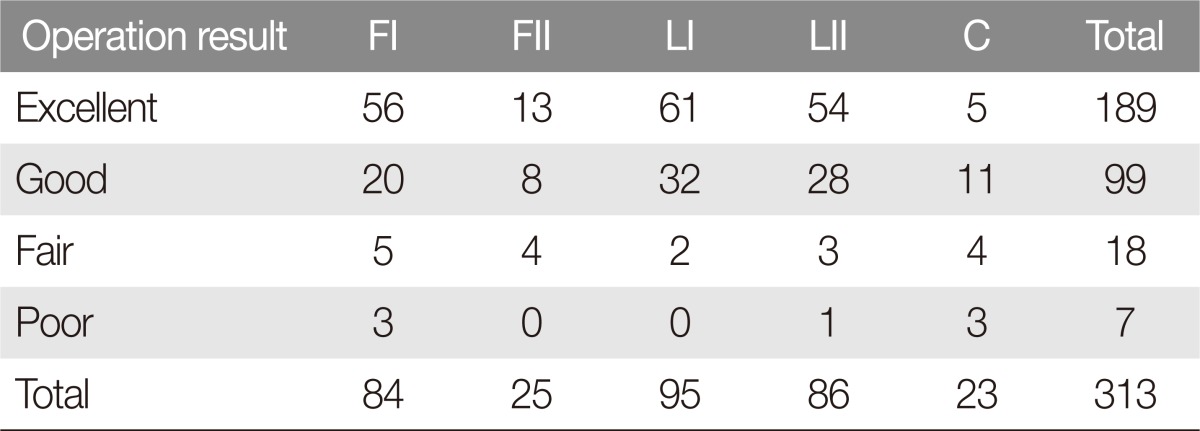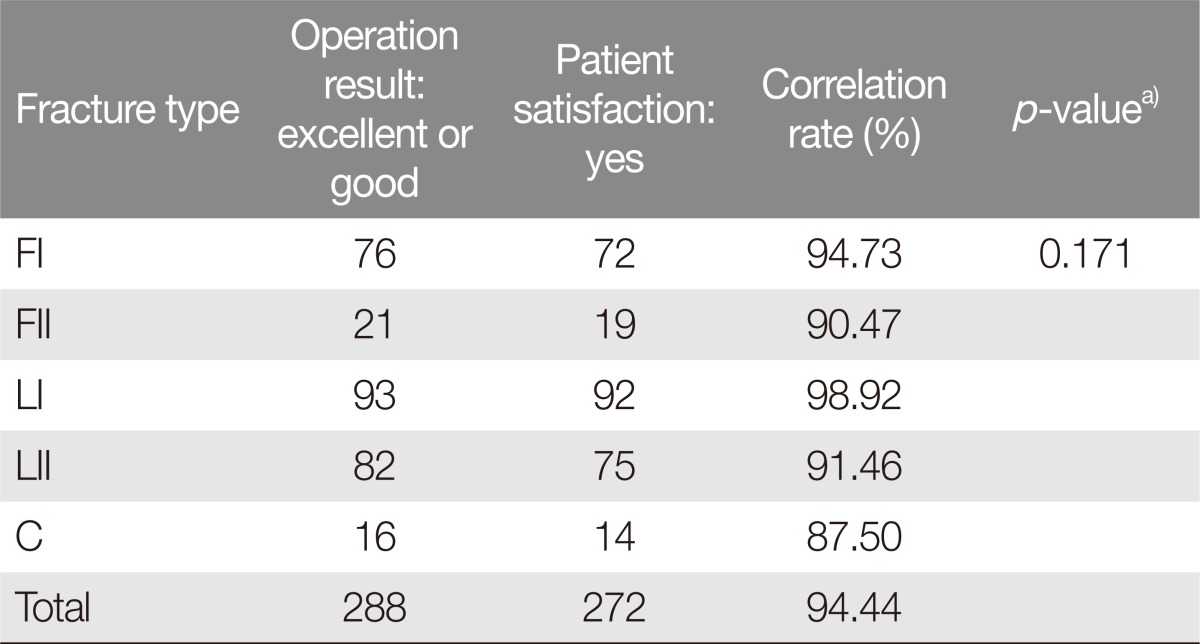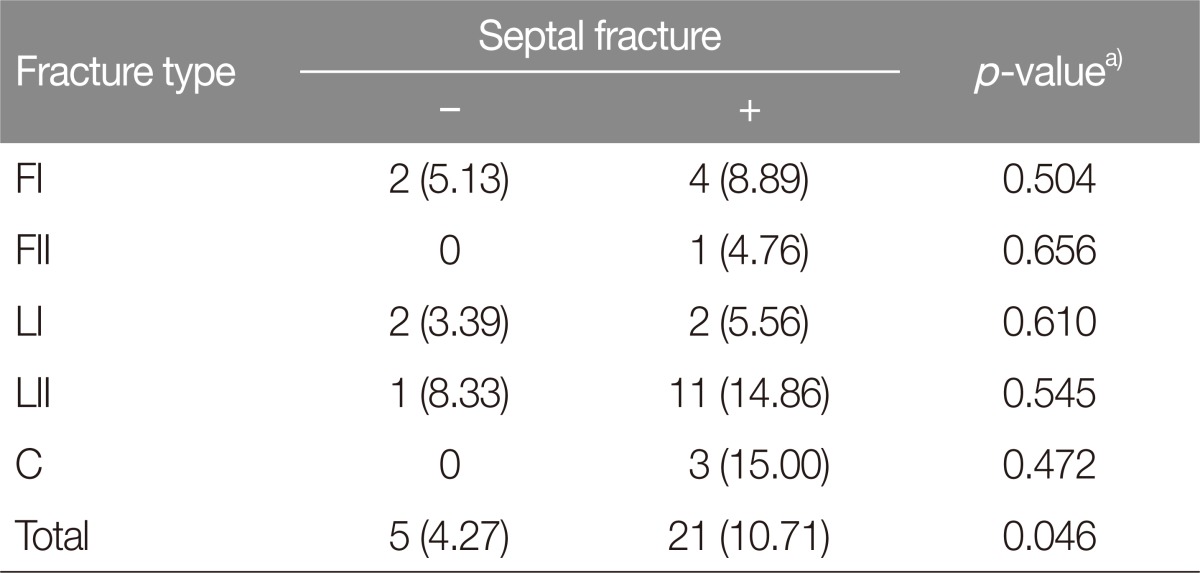 |
 |
- Search
| Arch Craniofac Surg > Volume 18(1); 2017 > Article |
|
Abstract
Background
Many authors have evaluated the post-reduction result of nasal bone fracture through patient satisfaction or postoperative complications. However, these results are limited because they are subjective. The aim of this study was to correlate an objective operation result with patient satisfaction and postoperative complications according to the type of nasal bone fractures.
Methods
Our study included 313 patients who had isolated nasal bone fractures and had undergone a closed reduction. Postoperative outcomes were evaluated objectively using computed tomographic (CT) images, while patient satisfaction was evaluated one month after the operation. The correlation of the operation result with patient satisfaction was then evaluated.
Results
The correlation between the operation result and patient satisfaction was highest for the lateral impact group type I (LI) type of fracture and lowest for the comminuted fracture group (C) type of fracture. However, there were no statistically significant differences in correlation between the overall result and patient satisfaction by fracture type. The complication rate of lateral impact group type II (LII), C, and frontal impact group type I (FI) fractures were statistically significantly higher than that of frontal impact group type II (FII) and LI fractures. There were no statistically significant relationships between the prevalence of complications and septal fracture or deviation according to the fracture type. In the total group, however, there was a statistically significant difference in complication rate by septal fracture.
Nasal bone fracture is the most common fracture of the facial bone. Most patients with nasal bone fractures undergo a closed reduction. However, only a few objective reports have been written on the results of a closed reduction on nasal fractures; some authors have analyzed the results using a questionnaire about a patient's satisfaction or experience with complications [1,2,3,4]. Since the nasal septum has an important role in supporting the nasal bone, a septal fracture or deviation can result in functional or esthetic problems [5].
The aim of this study was to evaluate the relationship between the objective result of an operation on nasal bone fractures and patient satisfaction. We also evaluated the postoperative complications of nasal bone fractures and their correlation with preoperative septal fracture or deviation according to the type of nasal bone fracture.
Patients who had undergone a closed reduction operation between March 2013 and June 2015 were studied. A total of 313 patients who were followed-up for more than 1 month after the operation were included in this study. Patients' sex, age and cause of trauma was collected by medical record.
The postoperative outcomes by computed tomographic (CT) images were evaluated as excellent, good, fair, poor, or very poor [6].
Excellent: Nasal deviation is absent; arch shape is smooth; no observation of malalignment of the fracture segment.
Good: Nasal deviation is absent; arch shape is smooth; malalignment is present, but with either a one-segment irregularity or displacement.
Fair: Nasal deviation is absent; arch shape is smooth; malalignment is present, with both bony irregularity and displacement.
Poor: Nasal deviation is present; arch shape is not smooth and with two segments of bony irregularity and displacement.
To characterize the fracture type, the classification by Stranc and Robertson [7] was used; frontal impact group type I (FI), frontal impact group type II (FII), lateral impact group type I (LI), lateral impact group type II (LII) and comminuted fracture group (C).
Patient satisfaction and any complications were analyzed 1 month after the operation. The satisfaction of postoperative nasal profile after 1 month was asked, and if the patient answered âyesâ, we classified the patient as âyesâ, if not, we classified the patient as ânoâ. Complication rate were analyzed by fracture type. The data about patient satisfaction and any complication was collected by chart review.
To evaluate the correlation between the operation result and patient satisfaction, we evaluated the rate of the number of patients who had excellent or good operation result and who were satisfied with the operation in each fracture type and total group.
To compare complication rate by the presence of septal fracture, we analyzed complication rate by the presence or absence of septal fracture/deviation in each fracture type and total group.
Fracture type and the correlation rate of operation result and patient satisfaction were compared using the chi-square test, fracture type and complication rate were compared using one-way analysis of variance, and Scheffe's multiple comparison method and Fracture type and the presence or absence of septal fracture/deviation were compared using the chi-square test (SPSS ver. 19.0, IBM, Armonk, NY, USA). The p-values <0.05 were considered to indicate statistical significance.
Of the 313 patients, 241 were male and 72 were female. The mean age was 32.1 years. Seventy-seven of the fractures were caused by bumping, 72 were caused by slips or falls, 67 were the result of beatings, 53 were caused by sports activities, and 44 were caused by traffic accidents (Table 1).
The excellent result was shown in 189 patients, good result in 99 patients, fair result in 18 patients, poor result in 7 patients. The operation result by fracture type was summarized in Table 2.
The correlation are shown in Table 3. In the FI group, 76 patients had excellent or good operation results, while 72 patients were satisfied with the operation. The correlation rate between operation result and patient satisfaction was 94.73%.
In the FII group, 21 patients had excellent or good operation results, while 19 patients were satisfied with the operation. The overall correlation rate between the operation results and patient satisfaction was 90.47%.
In the LI group, 93 patients had excellent or good operation results, while 92 patients were satisfied with the operation. The correlation rate between them was 98.92%.
In the LII group, 82 patients had excellent or good operation results, while 75 patients were satisfied with the operation. The correlation rate between them was 91.46%.
In the C group, 16 patients had excellent or good operation results, while 14 patients were satisfied with the operation. The correlation rate between them was 87.50%.
In total, 288 patients showed excellent or good operation results, while 272 patients were satisfied with the operation. The correlation rate between operation result and patient satisfaction was 94.44%.
The correlation rate was highest for the LI group and lowest for the C group. However, there was no statistically significant difference between the correlation rates by fracture type (Table 3).
Complications that occurred 1 month after the operation included hump nose, saddle nose, nasal vault widening, deviated nose, nasal obstruction, and temporary hyposmia. The p-value of the difference between each complication rate by fracture type was <0.001, which showed a statistically significant difference (Table 4). In other words, the complication rates by fracture type showed statistically significant difference.
To evaluate what's the difference between the complication rates by fracture type, we did a post-mortem analysis using Scheffe's multiple comparison method. Our examination revealed that the complication rates of the FI, LII, and C fracture types were statistically significantly higher than that of the FII and LI fracture types. However, there were no statistically significant differences in the complication rates between the FII and LI groups. There were also no statistically significant differences in the complication rates between the FI, LII, and C groups (Table 4).
There were no statistically significant differences between the prevalence of complication according to the presence or absence of septal fracture/deviation by each fracture type. However, the p-value of the difference in the total group was 0.046, which showed a statistically significant difference in complication rate by septal fracture/deviation in the total group (Table 5).
Many studies have reported on the results of the reduction of a nasal bone fracture in terms of patient satisfaction or rate of complications [1,2,3,4]. However, patient satisfaction is subjective and is limited to evaluating the operation results or related factors that influenced the result. And there were some cases that patient were not satisfied with their operation result even though there was no problem as evaluated by clinician. Therefore, in this study, we analyzed the direct and objective postoperative result using CT images. We then evaluated the correlation between the operation result and patient satisfaction with the prevalence of complications and type of septal fracture.
The proportion of the patient who were satisfied with their operation result which was âexcellentâ or goodâ were from 87.50% to 98.92% by fracture type, and there were no statistically significant differences between the correlation rates by fracture type. And in total group, the correlation rate was 94.44%. Therefore we concluded that when the operation result was more than good, about 90% of the patients were satisfied.
We found that there were 19 patients who were not satisfied with the operation, although their outcomes of the reduction operation were excellent or good. Among these patients, 8 (42.11%) were not satisfied with their postoperative results, although there were no subjective or objective complications. The other 11 patients (57.89%) had postoperative complications, such as hump nose, deviated nose, and nasal widening.
Lee et al. [8] reported the complication rate according to fracture type using the Stranc and Robertson classification, and found that the lateral impact group experienced more nasal deformities than the frontal impact group. In our study, complications of the LII (13.95%), C (13.04%) and FI (7.14%) groups occurred more often than complications of the LI (4.21%) and FII (4.00%) groups at a statistically significant level. From these results, we can conclude that the high complication rate of the lateral impact group was largely due to the LII group; the complication rate of the LI group was lower than the rate of the FI group. Since the C group had the most severe feature of displacement of fracture segments and septal fracture, the possibility of complications in the C group was higher than for the other groups.
Sam et al. [5] reported on the association between septal deviation of the nose and external nasal deformity. Rhee et al. [9] reported that most nasal fractures involved the septum, which can provide an obstacle to the successful reduction of nasal bone fractures. Murray [10] reported that the cartilaginous bending of the septum leads to long-term nasal deviation after an apparently initial satisfactory nasal manipulation.
In our study, we found no statistically significant relationships between the prevalence of complications of nasal bone fractures and preoperative septal fracture/deviation according to each fracture type. However, there was a statistically significant relationship between the prevalence of complications of nasal bone fractures and preoperative septal fracture/deviation in the total group.
In conclusion, it seems that the CT outcomes correlated with overall patient satisfaction. The complication rate by fracture type showed a statistically significant difference and there was a statistically significant difference in complication rate by septal fracture/deviation in the total group.
References
1. Love RL. Nasal fractures: patient satisfaction following closed reduction. N Z Med J 2010;123:45-48.
2. Oh HK, Park YJ, Kim HS, Ryu JY, Kook MS, Park HJ, et al. A recent 5-year retrospective study on nasal bone fracture. J Korean Assoc Oral Maxillofac Surg 2008;34:230-236.
3. Chung SH, Park J, Choe J, Baek SM. Clinical analysis of satisfaction of nasal bone reduction. J Korean Soc Plast Reconstr Surg 1994;21:984-990.
4. Hong SB, Choi BW, Suh IS, Ha JH. Clinical and radiological evaluation of the nasal bone fractures. J Korean Soc Plast Reconstr Surg 1996;23:1572-1582.
5. Sam A, Deshmukh PT, Patil C, Jain S, Patil R. Nasal septal deviation and external nasal deformity: a correlative study of 100 cases. Indian J Otolaryngol Head Neck Surg 2012;64:312-318. PMID: 24294569.


6. Lee BM, Han DG. Acute bone remodeling after reduction of nasal bone fracture on computed tomography imaging. Arch Craniofac Surg 2014;15:63-69.



7. Stranc MF, Robertson GA. A classification of injuries of the nasal skeleton. Ann Plast Surg 1979;2:468-474. PMID: 543615.


8. Lee JH, Park WY, Nam HJ, Kim YH. Complications of the nasal bone fractures according to the stranc classification. J Korean Cleft Palate-Craniofac Assoc 2008;9:62-66.
9. Rhee SC, Kim YK, Cha JH, Kang SR, Park HS. Septal fracture in simple nasal bone fracture. Plast Reconstr Surg 2004;113:45-52. PMID: 14707621.


10. Murray JA. Management of septal deviation with nasal fractures. Facial Plast Surg 1989;6:88-94. PMID: 2487870.



Table 4
Complications

Values are presented as number or number (%).
FI, frontal impact group type I; FII, frontal impact group type II; LI, lateral impact group type I; LII, lateral impact group type II; and C, comminuted fracture group
a) Complication rate by fracture type; b)One-way analysis of variance. Scheffe's multiple comparison result: FII, LI<FI, LII, C.
- TOOLS
-
METRICS

-
- 7 Crossref
- Scopus
- 4,166 View
- 100 Download
- Related articles in ACFS
-
The Relationship between Explanation and Patient Compliance in Hirudotherapy2017 September;18(3)
Delayed Reduction of Nasal Bone Fractures2016 June;17(2)
C-Arm Fluoroscopy for Accurate Reduction of Facial Bone Fracture.2013 October;14(2)
Delayed Reduction of Facial Bone Fractures.2013 October;14(2)









